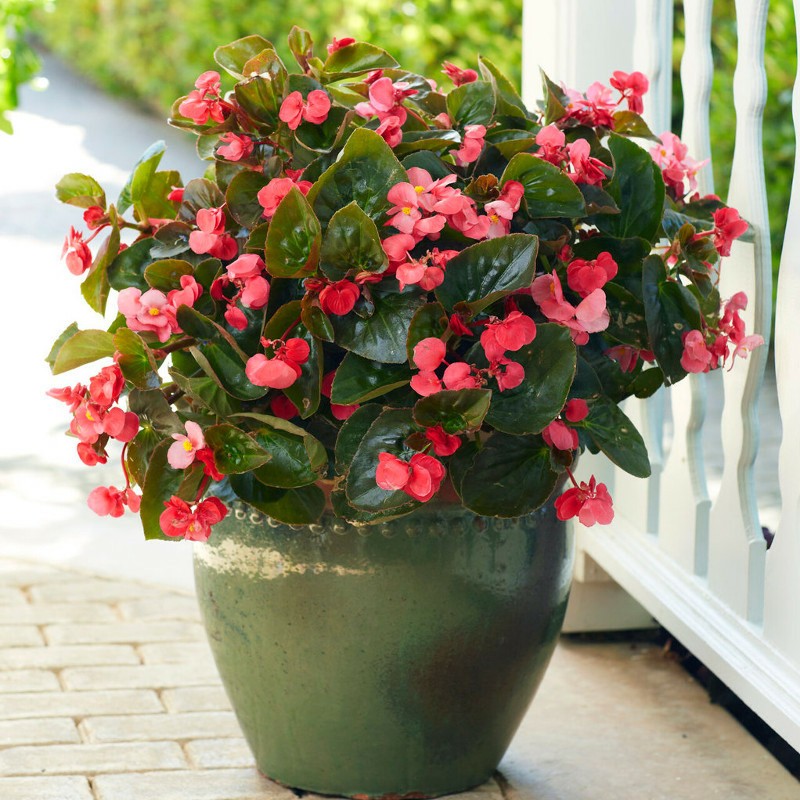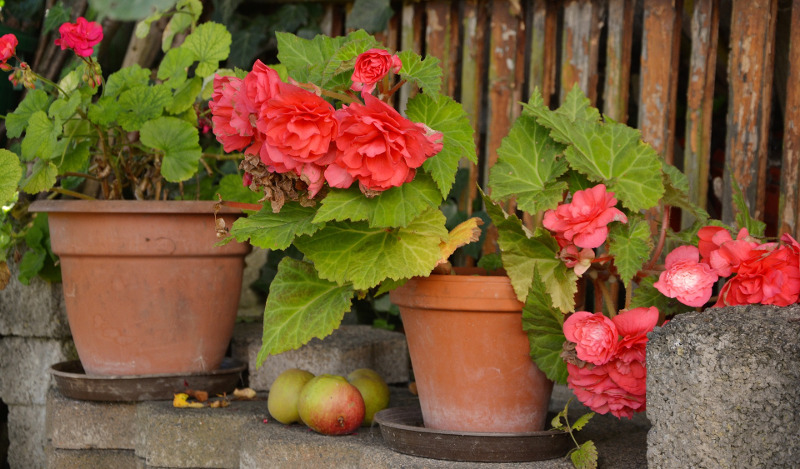The Begonia family contains 2,000 species – one of the largest genera of flowering plants. They are native tropical and subtropical areas of Central and South America, Asia, and Africa, where the air and soil tend to have consistent moisture. One distinguishing feature is that the colorful flowers technically have sepals rather than petals. Their root structures can be tuberous, fibrous, hardy, or rhizomatous.
There are varieties typically grown indoors like rhizomatous ‘Rex’ Begonias, known for their striking foliage, and those which can make stunning summer accents in hanging baskets or containers. Overall, they like even moisture, but not soggy roots, and most prefer some shade from the hottest sun.
An exception is the tuberous Begonia boliviensis ‘Encanto’ series blooms all summer in full sun. They tend to propagate easily from leaf cuttings. Typically, most are only hardy in USDA zones 8-11.

Planting Begonias
Choose a Begonia hardy to your climate zone, or plan to take inside as a houseplant in winter. Find a location for your Begonia that is protected from the afternoon sun or drying winds, and that has consistent moisture and soil high in nutrients and organic matter. Tuberous types can be started early in pots inside, but wait to plant outside until soil temperatures are above 60 degrees F.
In cool climates, they can take more sun if they are mulched and well-watered. Dig a hole twice as wide and as deep as the root ball. Water well, and mulch to keep roots moist and cool.

Watering Begonias
Begonias don’t like to dry out, but neither do they like wet feet. They like that sweet spot of “moist and well-drained” soil conditions. Going too wet or too dry can cause buds to close up or drop off. Give your Begonia at least an inch of water per week, more while getting established during dry or hot weather.
Keep your plant mulched to preserve moisture at the roots. Two to four inches is a good depth for mulching with organic matter like composted leaves. Indoors, to drain away excess fertilizer salts, water with distilled water monthly. When indoors, misting the air rather than the leaves helps raise humidity.
Fertilizing Begonias
Begonias like to be fed consistently for the best performance. A balanced fertilizer used at half strength every other week will give good results in the early part of the growing season. A ration of 5-1-1 is recommended. Once buds set add a dilute liquid low-nitrogen fertilizer weekly.

Pruning Begonias
The only pruning needed is if plants become leggy. Pinching the growth tips above a growing leaf can be done early preventatively, or at any time during the growing season. The best time for dividing is spring. If you are taking a tuber to overwinter inside while dormant, let foliage suffer a light frost, allow it to dry lying on its side for a couple of weeks until the foliage comes away easily.
Clean off and dry out the tuber to store. Wrap each tuber separately in newspaper or put them in small paper bags. Store these in a cardboard box, in a dry, dark place where the temperature is about 50 degrees.
Caring For Begonia in Pots
When temperatures are over 55 degrees F, you can plant a potted Begonia outdoors. Choose a Begonia hardy to your climate zone, or plan to take inside as a houseplant in winter.
Make sure your pot has good drainage and is at least four inches wider than the root ball. Dig a hole twice as wide and as deep as the root ball. Water well, and mulch to keep roots moist and cool. Water at least once a week, more if conditions are hot or dry. Mulch at least two inches deep to preserve moisture. Fertilize with a balanced fertilizer such as a 5-1-1 formula at half-strength twice a month.
In winter, if hardy to your area, protect the pot with frost cloth and move against a warm but sheltered wall. If not hardy, bring inside, cut back on watering, put in a bright morning sun location, and stop fertilizing. Try to ensure warm days and cool night temperatures. Mist regularly or use a humidity tray. Alternatively, you can let the plant’s leaves yellow, and keep dormant in a cool (not freezing), dark place. Repot or divide in spring.

Winter Care for Begonia
In winter, in zones 8-11 where they may be hardy, protect the pot with frost cloth and move against a warm but sheltered wall. If not hardy, bring inside, cut back on watering, put in a bright morning sun location, and stop fertilizing.
Try to ensure warm days and cool night temperatures in a range of 66 to 75 degrees F. Mist the air regularly (making sure not to wet the leaves) or use a humidity tray to keep the air at optimum humidity. Alternatively, you can let the plant’s leaves yellow, and keep dormant in a cool (not freezing), dark place.
If you are taking a tuber to overwinter inside while dormant, let foliage suffer a light frost, allow it to dry lying on its side for a couple of weeks until the foliage comes away easily. Clean off and dry out the tuber to store.
Wrap each tuber separately in newspaper or put them in small paper bags. Store these in a cardboard box, in a dry, dark place where the temperature is about 50 degrees. Replant outdoors when temperatures are over 55 degrees F.
Common Begonias Care Questions
What Is Causing Black Mold On My Begonia?
Far and away, the most common cause of mold on begonia leaves is overwatering and leaving the plant sitting in wet soil. Begonias like the humidity but not waterlogged soil or wet leaves. Avoid watering misting in the evening hours, or allowing water to sit on the leaves.
Do Begonias Like Sun Or Shade?
Most varietals of begonia will grow and flower best in partial shade, 4-6 hours of direct sunshine preferably morning sun and afternoon shade or filtered or dappled sun. They will tolerate full shade, though the foliage will not be as dense, and flowering will be less. There are a few begonias that will do well in full sun.
Do Begonias Come Back Every Year?
Begonias are mostly known as tender perennials, and in warmer climates can survive the winter with some additional care and protection. In other climates, they can be brought indoors for the winter. Most often though, they are treated as annuals.
Do Begonias Spread?
Why do begonias leave turning brown?
Are Begonias Drought Tolerant?
While most begonias prefer partial shade and consistently moist soil, they can tolerate both full sun and drought conditions.
What Is The Growth Rate Of A Begonia?
Begonias are fairly rapid growers.
Have a question about Begonias? Fill out the form below and we will try and get back to your question as soon as possible. We may even feature your question on this article to help other gardeners!
 |
Author Erica Browne Grivas - Published 07-22-2021 |
